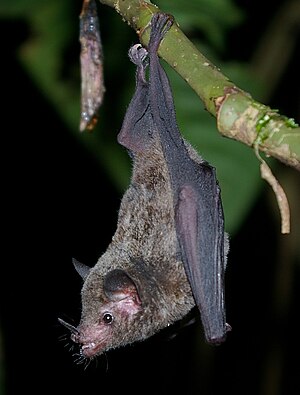Commissaris flower bat
| Commissaris flower bat | ||||||||||||
|---|---|---|---|---|---|---|---|---|---|---|---|---|

Glossophaga commissarisi |
||||||||||||
| Systematics | ||||||||||||
|
||||||||||||
| Scientific name | ||||||||||||
| Glossophaga commissarisi | ||||||||||||
| Gardner , 1962 |
The Commissaris flower bat ( Glossophaga commissarisi ) is a flower bat from the leaf-nosed family (Phyllostomidae) that is native to Central and South America.
description
The Commissaris flower bat is a rather small species of bat with an average weight of 9 to 10 grams. The fur is dark brown and monochrome. As with many bat species, however, partial albinism can sometimes occur, which is characterized by small white spots in the otherwise normal colored fur. Like most representatives of the leaf noses , Glossophaga commissarisi also has a distinctive nasal leaf .
The generic name Glossophaga is derived from the Greek glossa (= tongue) and phagein (= to eat). The type commissaris's long-tongued bat was named after Larry R. Commissaris, one died young graduate students and colleagues of the describer of nature, AL Gardner.
Way of life
The Commissaris flower bat hangs in caves, buildings and hollow living trees during the day. Although the species is one of the flower bats , it feeds not only on nectar and pollen , but also on insects and fruits, which is why this species is considered a food opportunist rather than a specialist.
Because of their diet, flower bats are important pollinators of plants. Well-known plants that are pollinated by the Commissaris flower bat are the cactus Weberocereus tunilla and the climbing plant Mucuna holtonii from the legume family .
Reproduction
Females become sexually mature around a year old. Pregnant females were caught in both the first and second half of the year, so Glossophaga commissarisi is believed to be bimodal polyoestrial . One study recaptured females who were pregnant at both times in the same year. These bats can give birth to young animals twice a year.
distribution and habitat
The distribution of the Commissaris blossom bat ranges from Mexico via Panama , Colombia , eastern Ecuador and Peru to northwestern Brazil , where the species occurs up to an altitude of 2,400 meters above sea level. Their population is classified by the IUCN as stable and safe thanks to their widespread distribution and occurrence in protected areas.
literature
- Wm. D. Wester & JK Jones Jr .: Glossophaga commissarisi , Mammalian Species , No. 446 (1993): pp. 1-4
Web links
swell
- ↑ M. Tschapka, O. von Helversen, W. Barthlott (1999): Bat pollination of Weberocereus tunilla, an epiphytic rain forest cactus with functional flagelliflory. Plant Biology 1, pp. 554-559
- ^ D. von Helversen & O. von Helversen (1999): Acoustic guide in a bat-pollinated flower. Nature 398, pp. 759-760
- ↑ M. Tschapka (2005): Reproduction of the Bat Glossophaga commissarisi (Phyllostomidae: Glossophaginae) in the Costa Rican Rain Forest During Frugivorous and Nectarivorous Periods. Biotropica 37, pp. 409-415
- ↑ Glossophaga commissarisi in the IUCN Red List of Threatened Species

